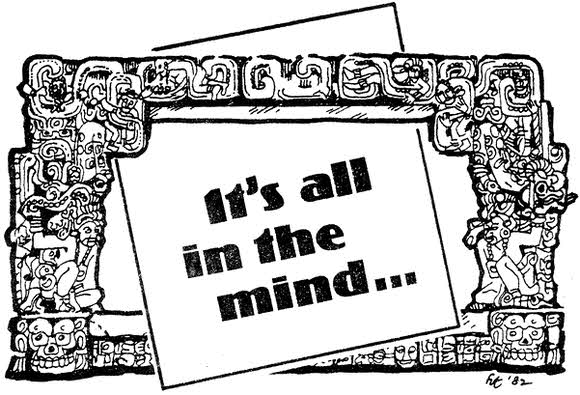
| FOOTNOTES TO FANDOM #10 | FOOTNOTES Page | Obituary Page | |
| |||
|
During a brief stay at a scholastic retreat near Mold, on the Welsh border, I met a party returned from a visit to the nearby Offa's Dyke. In a state of near ecstacy they described the deep feelings of the ancient past that assailed them on the site. Well, I thought, this I had better try for myself. I went. There indeed were the grassy dips and hollows that marked the earthwork but for me no deep feelings welled up from the springy turf. No all-pervading sense of history invaded my my mind. It may be that you have to possess the right sort of imagination to be an archeologist. It's easy to enthuse over the obvious - the ruins of castles, cathedrals and monasteries, prehistoric sites like Stonehenge and Avebury, Roman remains such as Hadrian's Wall... Though as far as the wall is concerned, when I visited Stacksteads I stared hard at places about which a guide waxed poetic but all that met my gaze were the inevitable grassy dips and hollows, which failed to come up to expectations, no matter how I fed my imagination with the glowing words. I am consoled by the fact that even a writer of the calibre of Aldous Huxley shared my plight. In his book Beyond the Maxique Bay he describes a visit to the classic Mayan site of Copan, in Honduras, in 1933. He dwells on the encroachment of time, and its allies in destruction - weather and vegetation - and the curious tricks they play on the works of men. They can destroy a city as an architectural and engineering unity, he wrote, yet spare its decorative detail. While great masses of masonry are buried or disrupted by the blind growth of vegetation, the statues, fragile pots and jewelry survive intact. At Copan he found all that remained of the great complex of platforms, pyramids, and sunken courtyards that once occupied the site, were a few mounds covered with trees, fragments of a wall, and rubbish heaps of stones. "Buried under the mould, disintergrated by the thrusting roots of the tropical vegetation, a sacred city of pure geometrical form once stood here... but toiling up and down through the scrub, among the fallen stones, I found it all but impossible to reconstruct in my imagination the Maya's huge embodiment of a mathematician's dream. I had read the writings of the archeologists and knew what sort of monument had been raised at Copan. But these almost shapeless burrows supplied my fancy with no visible foundations on which to rebuild the Maya's prodigious works." Huxley's fear that buried Copan (bought in 1839 by the American explorer John Lloyd Stephens for a mere 50 dollars) was irrecoverable is now confounded by the sheer industry of archeologists. Today the site is revealed as one of the most highly organised architectural complexes to be found in the Maya area of Central America. The ball-game court is cleared and reconstructed. The great mass known as pyramid 26 is crowned with elegant buildings, reached by the impressive Great Hieroglyphic Stairway with a whole 'book' of 2,500 glyphs carved on the risers of it's 63 steps: the longest inscription found in Mayan territory. The already ruined building known as Temple 22 was shattered by an earthquake after Huxley's visit. Now it has been meticulously restored on the basis of the careful records made by Alfred Maudslay during a visit in 1889. The many images of the Corn God found here have prompted some to call this the Temple of Agriculture: the magnificent sculptured entrance to the sanctuary is formed of a life-size figure on each side, squatting on giant death's heads and supporting a sky monster twisting in bizarre coils across the top. And throughout the site there are intricately carved stelae, larger than life-size figures, ornately robed and carrying ceremonial bars, imprisoned within a wealth of symbolic detail not yet clearly understood. One of the freestanding altars, with a dedicatory date of 776AD, shows 16 seated figures and appears to commemorate a congress of astronomers held at Copan on that date. The art of Copan is distinctive for the way in which architecture and sculpture are integrated. Contemporary descriptions include words and phrases like "breathtaking", "mellow poetry", and "one of the loveliest of all Classic Maya ruins". Maybe I should visit Stacksteads again just to see what they've been up to.... FOOTNOTES TO FANDOM #10...
Written July 1982, |
 |
